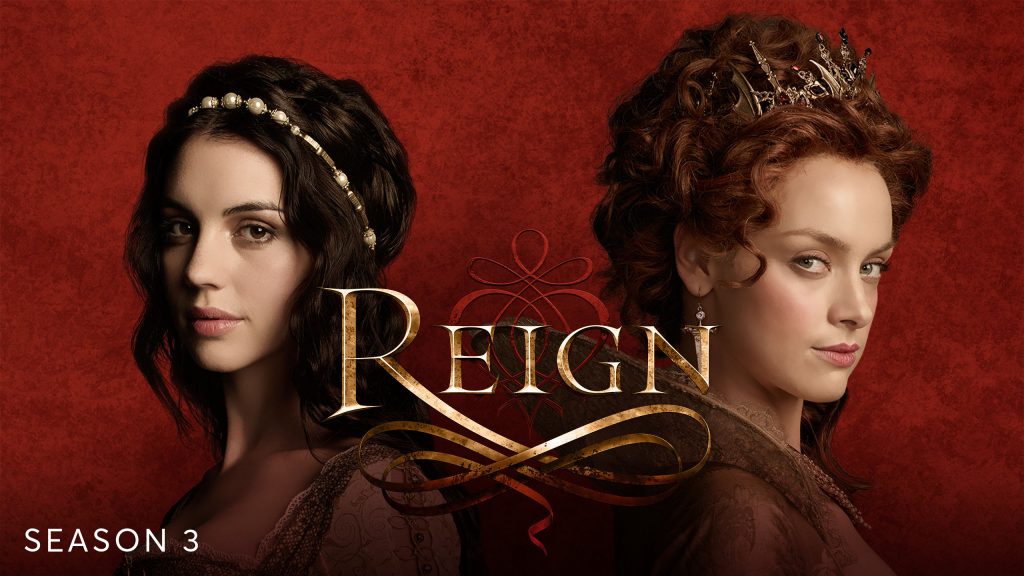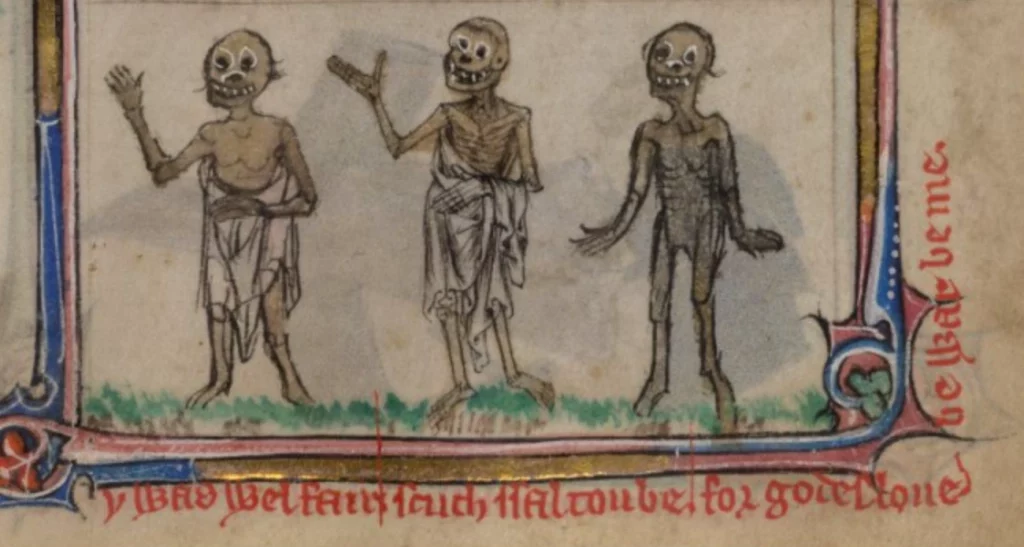Reign season three continues to give us a wildly entertaining and dramatic life of Mary, Queen of Scots. This time we have a new antagonist; Queen Elizabeth I of England. Historically, Elizabeth was Mary’s natural rival. They both had a claim to the English throne and being of opposing religions gave the people an obvious choice. The Protestants wanted Elizabeth and the Catholics wanted Mary, and this went far beyond the people of England to the international stage. There was plenty of historically rooted drama that Reign could draw from but that didn’t stop them from adding a lot of details that are entirely made up.
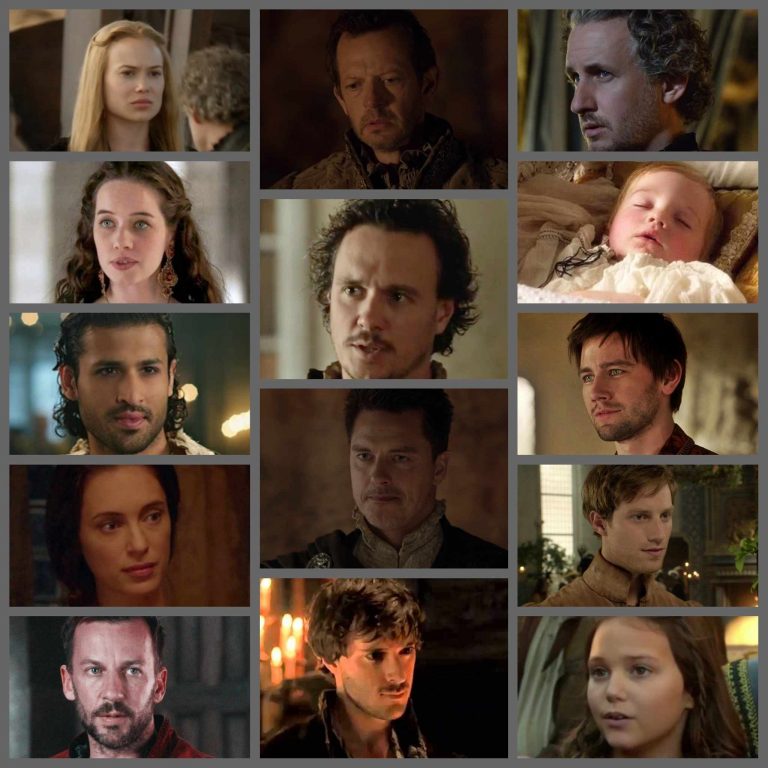
A very quick summary of the side stories that absolutely didn’t happen before we get into the more involving plot lines.
- Anything involving Greer and Lola didn’t happen. Lola’s entire experience at the English court and her fate definitely didn’t happen. They’re made up characters for the show and have no basis in history.
- As sweet as the love story between Claude and Leith is, that also didn’t happen. Claude had long been married to the Duke of Lorraine and was happy in her duchy.
- Catherine de Medici wasn’t nearly as sexually active in history as the show suggests and the court wasn’t afflicted by Christophe the serial killer.
- Likewise, anything involving the counter plot with Delphine and Bash didn’t happen because they too were fictional.
- Mary didn’t have an affair with the English Ambassador to France and Gideon is another fictional character.
- King Francis wasn’t killed as the result of a Scottish plot and Mary did not avenge his death by killing the fictional Munro.
- There was no Lady Beatrice Somerset but there was an Elizabeth Somerset, Countess of Worcester who informed on Anne and testified that she had committed incest with George Boleyn. The Countess of Worcester never benefitted from her evidence by receiving the Boleyn lands and she wasn’t later arrested by Queen Elizabeth.
The Death of Francis II
The Show: Season 3 starts with as much drama as it means to go on. In the opening episode, Mary’s husband King Francis reveals that he is not long for this world. He has an ear ache which signifies something deeper and doesn’t expect to live long. With this in mind, he puts all his energy and attention into preparing his brother Charles for the role of king and safeguarding Mary’s inevitable position as his widow. He also wants to make the most of things with his beloved wife and they pass their time kissing and sailing his new boat. Sometimes they kiss on the boat to mix it up.
While being in love, trying to secure the kingdom, and generally making firm decisions, Francis’ health deteriorates and eventually he succumbs to his illness and passes away in his wife’s arms.
Except he doesn’t!
In a dramatic twist, Bash and Delphine arrive and tell Mary that for the low low cost of someone else’s life, Delphine can resurrect Francis. Which she does, only for Mary’s mother, Mary de Guise, to expire on the spot in Scotland. Mary is sad but can get over it if it means that she has her husband with her and the two look forward to a long and happy reign together.
Their happiness lasts but half an episode. Fearing that Francis is still in danger, his mother, Catherine de Medici, begs him to be careful with his life. He assures her he will before promptly departing with Mary to Paris via a forest with minimal guards. Shockingly, after leaving the road and their protection for some skinny dipping, the happy couple are set upon by assassins. Francis heroically fights them off but in the process is mortally injured. He dies for the second time in as many episodes in Mary’s arms. This time for real real.
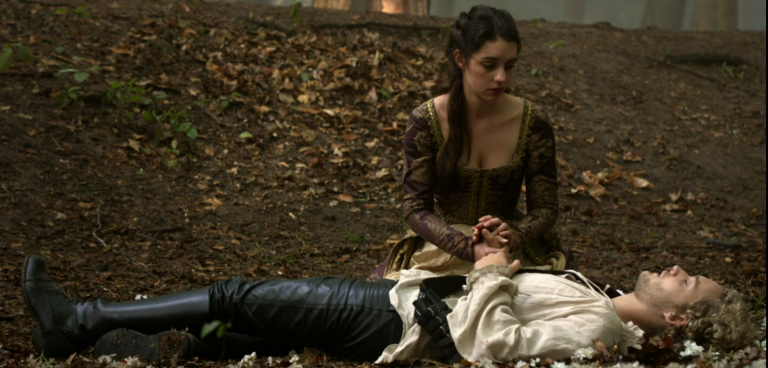
In History: Reign‘s Francis is played by actor Tony Regbo who was twenty-three during filming for this particular season. The historical Francis was much younger but the show would be infinitely less sexy if it played to accuracy. The real Francis was around fifteen years old for the events of the series and was what could generously be described as “a young fifteen”. He was physically frail and known by his people as ‘le petit roi’ (the small king) but this wasn’t a reflection of his age. His health was rumoured to be so bad that whenever he went out in public, his people would hide their children from him. There were tales of how his life could only be preserved by bathing in the blood of sacrificed children which, while likely untrue, really go to show how fragile the kid was. Incidentally, his penis was described by his doctors as being deformed (thought to be due to undescended testicles) which led to a belief that he would never have been able to have children if he’d been able to consummate his marriage at all. All in all, he was not the hale and hearty model of a monarch.
On the 16th November 1560, Francis went out hunting; his favourite pastime. He returned complaining of a deblitating ear ache and the following day he fainted at church. He was taken to his rooms and while it was common knowledge that the king was ill, the seriousness of his condition was kept to only his closest circle. Mary and Catherine de Medici argued over who would nurse him through the illness though both of them would end up being at his side as he steadily got worse. He had a couple of days of relief but this was just the calm before the storm. After rallying, he was quickly overcome by violent fevers and periods of speechlessness that no amount of leeching could cure.
By the 3rd December it was clear that the king was not going to recover and masses were said for him across France. Two days later he “fell into a swoon” and became delerious. He died later on that evening. Historians have never quite been able to determine what it was that killed Francis given that his official diagnosis was ‘ear chill from the Loire fog’. One of Mary, Queen of Scots modern biographers suggests a brain tumour, while others have theories of meningitis or complications from an infection. Whatever it was, it wasn’t the result of fighting off assassins. The person of the king was so well protected that they wouldn’t have gotten close enough anyway, skinny dipping in the Loire notwithstanding.
Mary, Queen of Widows and Don Carlos
The Show: In the aftermath of Francis’ death, Mary is devastated but knows she has to remarry. Having already lost the love of her life, Mary is now fully aware that her next marriage will be a political one and starts entertaining suits from potential suitors. To pre-empt her, Elizabeth I also puts herself on the marriage market, starting with Mary’s most obvious candidate; Don Carlos of Spain. He goes to England to meet with her and Elizabeth is on the brink of accepting his proposal when he challenges her to lift up her skirts and prove that she is a woman. He tells her that he’s heard otherwise and an outraged Elizabeth throws him from the court. He leaves England and arrives in France where he seamlessly moves into courting Mary and things get a little weird.
Don Carlos reveals to Mary that he really wants his future wife to dominate him and that he’s been travelling Europe with some kind of BDSM sex machine. He invites Mary to share the experience with him but she isn’t enthusiastic. In the end, she takes Catherine de Medici with her, blindfolding Don Carlos while Catherine “dominates” him in Mary’s stead. When he realises that someone else is present, Don Carlos tears off the blindfold and subsequently freaks out. Still shackled to his… toy, he stumbles and cracks his head open. His injuries are extensive, leading to seizures, and nobody expects him to survive. But survive he does! Albeit with the physical capacity of a small child and the mental capacity of one much smaller.
With Don Carlos seemingly permanently affected by his injury both Spain and Mary spy an opportunity. In Don Carlos, Mary will have a powerful ally that she can manipulate and exploit (something which she sets to immediately), and in Mary, Spain has someone who will hide their heir’s condition from the world and care for him. The two are about to be married when it’s revealed that actually Don Carlos has recovered his senses and having secured the Scottish crown, has hired assassins to remove Mary from the equation. Naturally, it doesn’t work and they aren’t married.
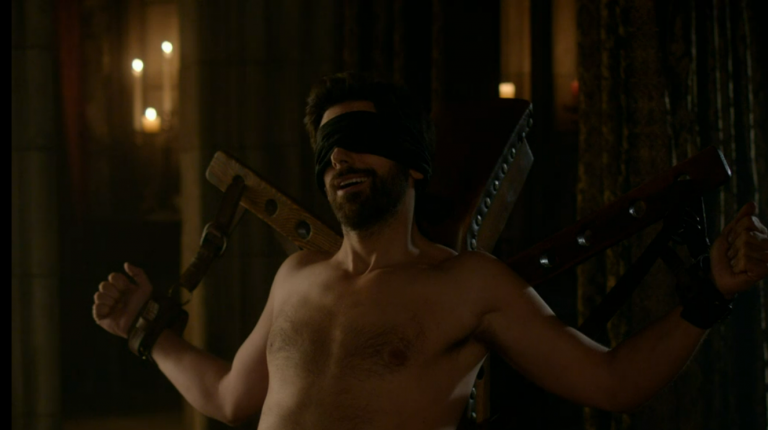
In History: Carlos, Prince of Asturias or Don Carlos as he was more commonly known was the son and heir of Philip II of Spain. He was the only child born to Philip and his first wife who died shortly after giving birth. Philip then went on to marry Mary I of England which produced no children as demonstrated by Elizabeth’s accession. When Mary was widowed Philip was on his third wife, Mary’s best friend and sister-in-law, Elisabeth Valois. Elisabeth had initially supposed to marry Don Carlos but Philip jumped in and took her for herself. Apparently they were quite affectionate. Anyway, the only reason I mention any of this is so that we can appreciate that despite being on his third wife, Philip had one (1) son and heir; Don Carlos.
As heir to the most powerful country in Europe, Don Carlos was a catch and at various times was on the market for both Elizabeth and Mary, Queen of Scots. He did not however, leave Spain to conduct these negotiations in person. Royal marriages were inevitably concluded by ambassadors and intermediaries. He never went to England to challenge Elizabeth’s genetalia. (As an aside, this part of the story is based on an actual Tudor rumour called ‘The Bisley Boy’ which suggested that Elizabeth had died as a baby and been swapped with a local boy. I’ve written more about it here but needless to say it was considered nonsense).
When it became clear that Francis II was going to die, Don Carlos was immediately entertained as a replacement husband for Mary. This didn’t mean he went to France. He did not travel Europe with a specially made sex chair and he didn’t have a bizarre liason with Mary and Catherine de Medici which left him almost paralysed. Also he didn’t get that close to marrying Mary. One thing that Reign does a lot is have characters accepting proposals left right and centre but at this time, the acceptance of a proposal was tantamount to marriage. Hence why negotiations took forever and were contracted through legal teams. If Mary and Don Carlos declared that they were to marry, that would count as a pre-contract at the very least and Mary would be Princess of Spain. In short; none of that happened.
The head injury is at least somewhat based in fact. Interestingly, and somewhat unbelievably, Don Carlos’ health was worse than Francis II. Don Carlos suffered from a number of physical impediments; his limbs were out of proportion, being of unequal lengths and his spine was malformed which led to a deformed stature. He was also unstable and sometimes violent, though this might have been from his emotionally neglected upbringing rather than the results of inbreeding or perhaps it was a combination of the two. Either way, things were not helped when he fell down the stairs (allegedly chasing a maidservant) and suffered a catastophic head injury.
It looked like he wouldn’t survive but after a month he started to show signs of recovery. His recovery wouldn’t be complete, however, and he would become violently unstable over the slightest provocation. Five years later, his situation became untenable and Philip had him imprisoned in his rooms. A year later, Don Carlos was dead possibly from having starved himself on a hunger strike.
Elizabeth I, Robert Dudley, and Amy Robsart (feat. William Cecil)
The Show: Elizabeth I is introduced as a main character for season three and with it her chief advisor and Secretary of State, William Cecil, and her love interest, Robert Dudley. From the off, Elizabeth and Dudley are passionately in love but with one minor setback; he’s already married. That doesn’t stop them sleeping together however and in a bid to recover her husband’s affection, we see Dudley’s wife, Amy, also having affairs of her own to try and influence court decisions that will see him sent home.
When that fails, Amy spreads a rumour that Elizabeth is actually a man in the hope of… Actually I’m not sure what her hope is. Probably just to discredit her rival. Either way, that fails too and she and Dudley start arguing so much that he almost strangles her before sending her away. Amy has another affair, this time with a doctor to claim she has a tumour which is going to kill her. That will surely win back Dudley but to further complicate matters, Elizabeth has fallen pregnant with their baby. Dudley plans to divorce Amy and marry Elizabeth and after more heated arguments, Amy commits suicide. When Dudley is tried for Amy’s murder, Elizabeth realizes that Amy killed herself to obstruct any potential marriage and possibly have her husband hanged into the bargain.
While Elizabeth debates whether she’s going to rid herself of the baby, the decision is made for her when she is poisoned, causing her to miscarry. A devastated Elizabeth is left utterly distraught when she discovers that her poisoner is Cecil, who is deeply in love with her and denounces how Dudley should have loved her from afar as he has. It’s revealed that Cecil sleeps with ladies that he calls Elizabeth and has wears red-haired wigs and Elizabeth is so disgusted she banishes him.
Unfortunately, she realizes that she wants to marry Dudley at the point where Dudley realizes that he cannot marry her despite their great love. The court doesn’t find him guilty of Amy’s murder but the shadow of her death hangs over him and in the face of growing hostility, Elizabeth feels the only way to save his life is to send him to France to court Mary.
Ultimately, despite a warm relationship with Mary, Dudley is restored to favour and eventually, many many episodes later, Elizabeth proposes marriage again. This time he reveals that after she sent him away, he married someone else; Lettice Knollys. Dun dun duuun.
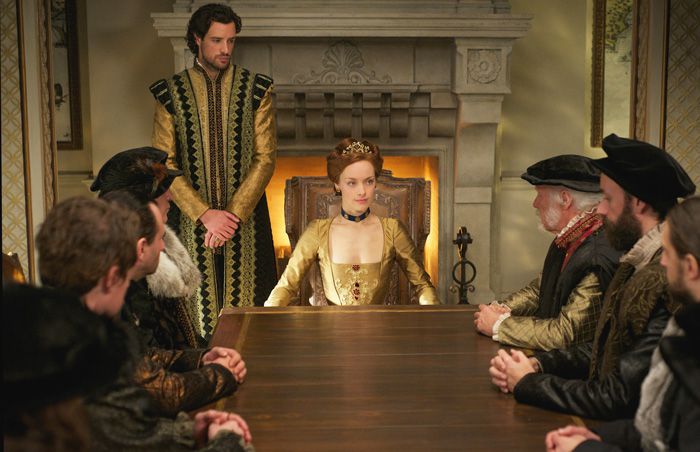
In History: I have already written in depth about Queen Elizabeth’s relationship with Robert Dudley so I won’t repeat myself. Suffice to say, if Elizabeth I ever took a lover, that man was Robert Dudley. Regardless of whether they acted on it, Elizabeth and Dudley were very much in love and probably were for most of their lives. There’s no evidence of a pregnancy though, which while is to be expected, I’d point out that there’s speculation that Elizabeth had previously miscarried a baby fathered by her stepfather (I know, gross) Thomas Seymour. But there was no such speculation supported beyond idle gossip for a potential child of Elizabeth and Dudley. (More on that in the BTS).
The question of Dudley’s wife, Amy, however is in an intriguing one. She did die in unusual circumstances by falling down a set of stairs that, by all accounts, couldn’t have killed anyone. There were rumours of illness, depression, suicide, murder, and five hundred years later we still don’t know what happened. There are some things we can say with certainty though; Amy did not have myriad affairs in an attempt to keep her husband with her though and she and Dudley didn’t see each other nearly as often as depicted in the show.
In the aftermath of Amy’s mysterious death, there was indeed an inquiry which found Dudley innocent but which, in the words of William Cecil, “forever infamed” him. He was also put forward as a candidate for Mary’s husband but the negotiations didn’t go anywhere and the two never met in person. Dudley made further attempts for Elizabeth’s hand over the years but none that she accepted. It was not for another twenty years from when this season is set that Dudley incurred Elizabeth’s wrath by marrying her cousin, Lettice Knollys.
As for William Cecil poisoning Elizabeth I, forcing her to miscarry because he’s jealous of Dudley and prefers to lust over her privately… No. Cecil was over a decade older than Elizabeth, which granted doesn’t mean much in this society, but his relationship with her was one of older confidante and advisor. He dedicated his life to serving and protecting her, even before she was queen and it could have him executed for treason. He was by her side as her most faithful servant for the majority of her reign.
The Vatican & Joseph Tudor
The Show: Mary visits the Vatican, meets with the Pope, and secures their support for the Scottish and English thrones. Elizabeth has offered Mary a confirmed place in the English succession in return for dictating the Queen of Scots’ choice of husband. Mary’s plan is to return to Scotland at the head of a Vatican army to take back her throne from the Protestant nobles who have control of it. Unfortunately, the Vatican has its own plan to then kill Elizabeth, and Mary having accepted the succession would become Queen of England. They would then get rid of her in favour of their Catholic Tudor cousin; Joseph Tudor.
Determined to save Elizabeth from assassination, Mary works with Dudley and Gideon. They thwart the Vatican, murder Joseph who can’t wait to be King of England, and Dudley returns to Elizabeth’s side having restored his good name by and preserving the Queen.
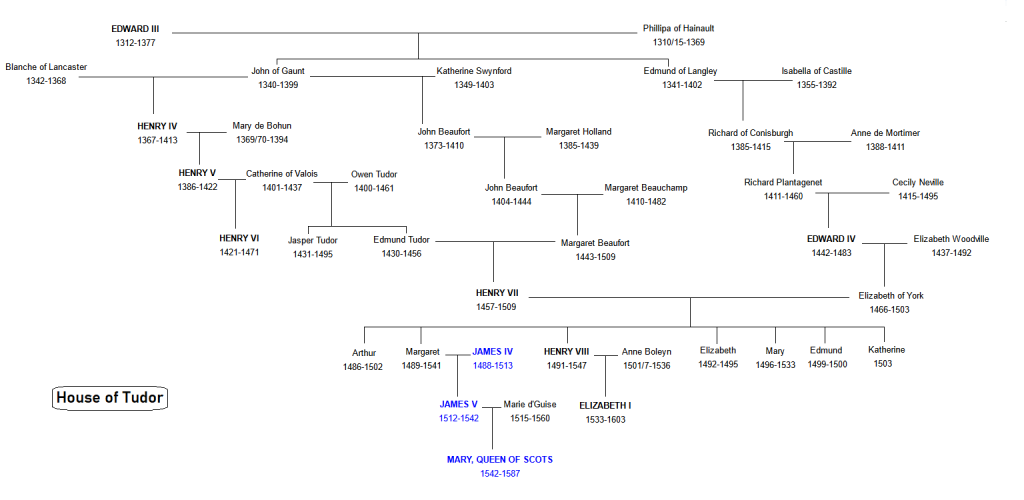
In History: Strictly speaking, this section is brief enough that it could have been included in the stories that didn’t happen because it’s fairly irrelevant. But it holds a singular honour in Reign. Three seasons in and this is the first time a story made up for the show actually annoyed me!
The character of Joseph Tudor didn’t exist. But this isn’t just a case of creating a fictional character or composite of other characters. Joseph Tudor, “the Catholic Tudor cousin with a claim to the throne” as Elizabeth calls him, could not have existed. Even if the children of Henry VIII were to have had Tudor cousins, they wouldn’t have had a claim to the throne. Henry VII’s royalty was traced through his mother, a Beaufort, so even though his name was Tudor, the blood claim was not. The only thing that the Tudors had any claim to were some estates in Ynys Môn (Anglesey). Any Tudor cousins, Catholic or otherwise, even fictional ones, would have to have been descended from Henry VII’s Uncle, Jasper Tudor, and would have as much claim to the English throne as the children of Pippa Middleton would today. For the show to have gone any further, i.e. by creating a fictional brother of Henry VIII to have had children would have been to give an invented character a greater claim to the throne than their titular Mary. In short; Joseph Tudor didn’t exist, couldn’t have existed, and if they had, they’d have been provincial Welsh dukes with names like Owain or Maredudd.
The Thirteen Knights and King Charles IX
The Show: With King Francis dead, the succession falls to his younger brother Charles who becomes King Charles IX. He doesn’t have the noble bearing of his deceased brother and instead seems to be shaping into a little sh*t. He’s arrogant and fripperous, with a penchant for women, opium, and gambling. Nonetheless, he is the king and one of his first acts is to assure Mary of his and France’s support in her attempt to return to Scotland.
Mary plays a formal role in Charles’ coronation but his reign gets off to a rocky start when thirteen mysterious knights swear to bring down the House of Valois. It’s revealed that they were once an elite fighting force recruited from orphaned boys who took vows of celibacy. This didn’t stop Catherine de Medici from securing their loyalty by offering them prostitutes but ultimately, the former King Henry had them all murdered rather than pay them for their work.
They work against the House of Valois, sabotaging the court and gradually turning the whole of France against its King. This culminates in an assassination attempt which fails but traumatises young Charles. The experience leaves him unstable and unwilling to rule. He begs his mother to let him abdicate but she threatens to murder him before she’ll let that happen.
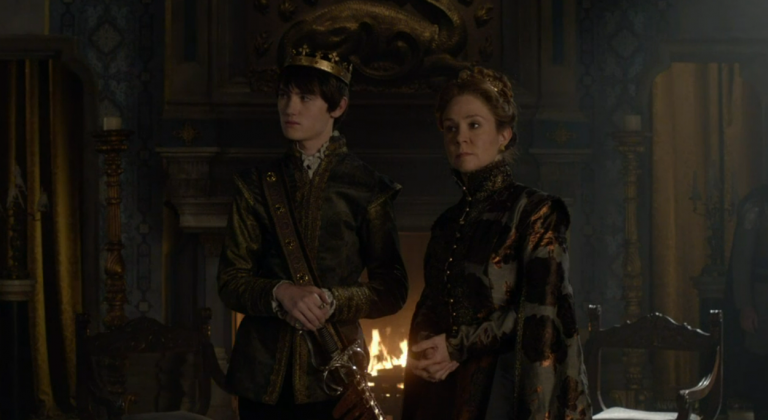
In History: Charles ascended the throne at ten years old and being ten years old, wasn’t much of a hedonistic womanizer. His mother, Catherine de Medici, was appointed Regent for her son but they weren’t terrorised by the entirely fictional Red Knights. Within a couple of years of his accession however, the French Wars of Religion would break out and dominate French politics for the next thirty years.
Charles would not live to see the end of the civil war. Ten years into his reign, having apparently proven himself to be weak willed and easily influenced, the leading nobles gathered for the wedding of Charles’s Catholic sister to their Protestant Bourbon cousin. Six days later, possibly at Catherine de Medici’s instigation, the Protestant nobles were slaughtered in the St. Bartholemew’s Day massacre. The massacre escalated and expanded out from the city of Paris and a total number of casualties has never been established. The lower estimates are around two thousand while the higher end sits at thirty thousand and it had a catastrophic effect on Charles’ already frail mental health.
By now, he was in his early twenties but suffering from tuberculosis and in the aftermath of the of the massacre he seemed to completely break down, exhibiting some of the behaviours the show demonstrates in his youth. He died shortly afterwards which goes way beyond the purview of the show but I have a feeling season four isn’t going to cover the length of Charles’ reign.
Mary, Queen of Scots vs John Knox
The Show: Following the death of Mary’s mother, the Protestants have taken control of the country, led by the preacher John Knox. Mary is due to sail back to Scotland but before she does, she takes a brief moment to lead her army against the rebel French trying to overthrow Charles. Rebellion supressed and the Valois secure, Mary freaking finally returns to Scotland.
Despite crossing at a time when they know the English navy won’t be waiting for them, Mary’s escort is shipwrecked and Mary ends up washed up on a Scottish beach. Those who accompanied her are slaughtered by rogue Scots and though Mary escapes, the Scottish council, led by her half-brother, James, believe her to be dead.
In her absence, John Knox tries to convince James to dissolve the monarchy once and for all creating a Scottish republic. He succeeds too, only to be interrupted at the very moment of dissolution by Mary’s grand entrance. She’s back having been rescued by druids, avenging Francis by killing the Scottish lord responsible for his death, and now she’s ready to take her throne.
Knox isn’t deterred however and makes a point of arguing with Mary at every opportunity. But Mary won’t bite and continues a policy of religious tolerance. She’s happy being Queen of Scotland and has even learned to live in peace beside her English cousin. That is, until Elizabeth has Mary’s bestie Lola executed. Incensed, Mary declares a personal war on Elizabeth, determines to dismantle the English crown and declares herself Queen of England. Behind the scenes, Knox is laughing. He orchestrated the whole thing as part of a grand plan to end monarchy in Britain and establish a Protestant Republic.
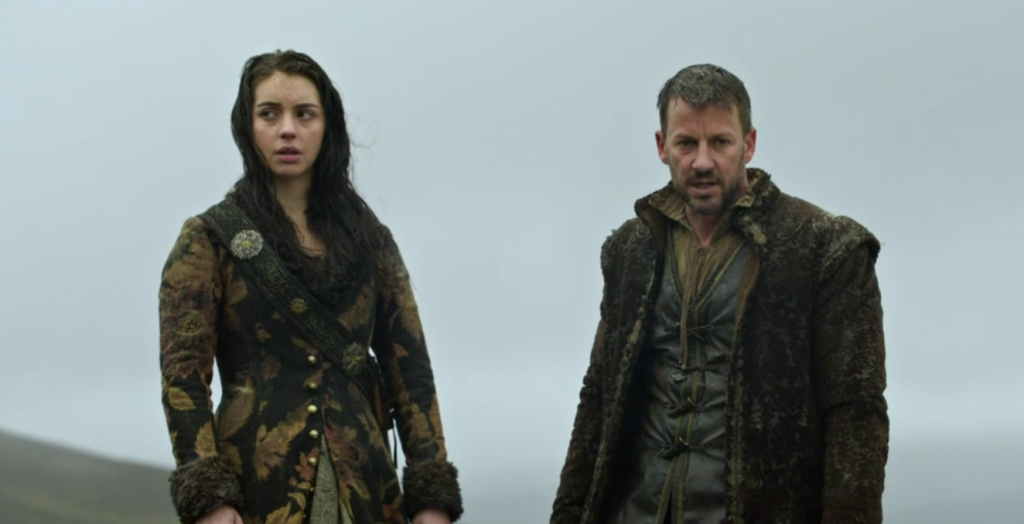
In History: Mary’s return home was far less dramatic than depicted. She didn’t have to arrange an army to escort her back and there was no shipwreck. With the exception of some political red-tape regarding the legal implications of her safe passage, her return was a relatively straight-forward process: Francis died. Mary mourned. She decided to return to Scotland. She returned to Scotland.
She was back in Scotland before the coronation of the new King Charles and the most drama came from her swift passage which saw her arrive early, before anyone was prepared to receive her. The transference of power was a simple affair though she did surprise everyone by adhering to a policy of religious tolerance.
The preacher, John Knox, would prove to be her greatest critic and largest political opponent. Knox stands out as a misogynist even by the standards of a time where the inferiority of women was believed as a matter of course. He did not believe that women could rule and Mary had the additional deficiency of being Catholic. Despite her many and repeated accessions to her Protestant subjects, Mary could never have satisfied Knox. He called for her conversion but there was nothing she could do about her gender which was his main complaint against her.
Reign actually correctly depicts Knox’s attempt to obstruct Mary’s first mass. But Mary and her brother were both fiercely committed to mutual religious tolerance and so, when Knox tried to disrupt Mary’s worship, James himself intervened and stood guard. But for all Knox’s animosity towards the queen, he wasn’t a republican. The idea of no monarchy at all is still a radical one to most British people, during the sixteenth century it wasn’t even on their radar as an impossibility. To that end, he also didn’t engineer the execution of the Queen’s best friend by a rival queen as part of some big plan to dismantle the monarchy.
The season ending with Mary declaring a vendetta against Elizabeth is dramatic but didn’t happen. For a start, Lola is fictional as was her execution. The Queen of England wouldn’t have been in a position to execute a fellow queen’s lady, the wife of a prominent French courtier, and the mother of the King of France’s only child, bastard or not. The reality of this time was far more mundane even for a time as dramatic and tumultuous as Tudor England and Stuart Scotland. Mary was, in fact, making overtures of peace to her cousin and trying to arrange a meeting. That kind of diplomacy doesn’t really make for good watching.
If you’re interested in reading more, I recommend Mary, Queen of Scots by Antonia Fraser or ‘My Heart is My Own’: The Life of Mary, Queen of Scots by John Guy. Purchasing through these affiliate links helps to support this site.
If you’d like to join me for more fun and games in picking apart history, and other behind the scene tangents, you can support me via my Patreon.

